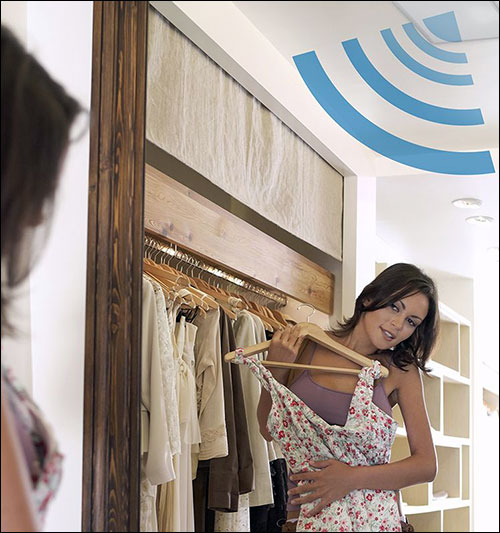Multiple retailers in the United States and Europe are trialing Tyco Retail Solutions‘ new steerable-beam ultrahigh-frequency (UHF) RFID antenna that, according to the company, can indicate not only a tagged item’s location, but also the direction in which it is moving. The trials are intended to test whether the new IDA-3100 antenna, used with Tyco Retail Solutions’ Sensormatic IDX 2000 or IDX 8000 reader and TrueVue software, can provide details regarding how items move within a specific space, such as a fitting room or doorway, and the ways in which customers interact with products.
Tyco says it developed the new antenna to provide a way to bring greater intelligence to passive UHF RFID deployments without greatly increasing cost. Currently, the company explains, most UHF RFID deployments in stores involve the tracking of tagged items by means of a handheld reader or a fixed portal in an area between the backroom and sales floor. This, however, brings limited information to a store manager. Alternatively, a retailer could deploy real-time location system (RTLS) technology in order to locate all items within a store in real time. RTLS technology can provide a vast amount of visibility, but it is often cost-prohibitive, according to Randy Dunn, Tyco Retail Solutions’ director of global sales and professional services. “We saw a gap in the market place,” he says, adding that the IDA-3100 is designed to fill that void.

The IDA-3100, which measures 33.8 centimeters by 37.2 centimeters by 1.9 centimeters (13.3 inches by 14.6 inches by 0.7 inch), is designed to have a low profile and be mounted on walls or ceilings at transition points, such as in fitting rooms, entrances to fitting rooms, point-of-sale areas or doorways. The antenna emits an RF beam that sweeps across the read zone in front of the antenna, thereby reading a tag multiple times as it moves past the antenna, and identifying the direction in which the tag is moving. By knowing the direction of a tag’s movement, store managers can track when goods move from a stock room to the sales floor, determine which garments are taken into a fitting room, as well as how long they remain there, or track an item’s movement on the sales floor and toward a doorway. The system is not designed to provide RTLS functionality for an entire store, Dunn notes, but rather to operate in very specific locations within the store where product movement may be of greatest interest.
TrueVue software can provide analytics, such as which items are being taken into a fitting room most frequently, and how often those fitting room sessions lead to sales. The software can also provide real-time alerts to personnel, such as when items have collected in the fitting rooms, are no longer in use and need to be returned to the sales floor.
The deployment of the IDA-3100 antenna, Dunn says, could lead to a more consumer-facing solution in which shoppers could access data about the products they bring into a fitting room—for example, which other items like a particular product may be available in the store, and which goods they could order online while at the store if they are not physically available at that location. “We expect this to be a first step,” he states.
A single Sensormatic IDX-8000 reader could support as many as eight antennas. As such, a tag’s ID and movement within its read zone, such as in one of eight separate fitting rooms, could be monitored.
A traditional fixed beam antenna either transmits a narrow beam in one single direction or spreads all of its RF energy over a wider beam. The IDA-3100 focuses a narrow RF beam on a particular zone (left, center or right) and then switches that focus to the next zone, sweeping across the field around it to achieve higher energy concentration over a wider area. This, Dunn says, not only results in an improved ability to read tags, but also movement identification.
According to Dunn, the IDA-3100 is already installed at a large North American specialty retailer and a major U.K.-based retailer, both of which have asked to remain unnamed.
“We have also conducted field verification testing of this antenna’s performance at the exit,” Dunn says. Such testing included the incorporation of the new antenna into a Sensormatic dual-tech (AM/RFID) UltraExit pedestal, designed to be mounted at the store exit in order to collect data for tracking inventory accuracy and shrinkage, and an RFID electronic article surveillance (EAS) system for theft detection. For these tests, Tyco EAS tags with EPC UHF RFID inlays built into them were attached to products. The IDA-3100 antenna—installed in the pedestal so that its center beam pointed across the doorway—successfully identified the movements of any un-purchased items as they approached the exit. When those products entered the read zone directly in front of the antenna, an alert was issued or an alarm was sounded.


